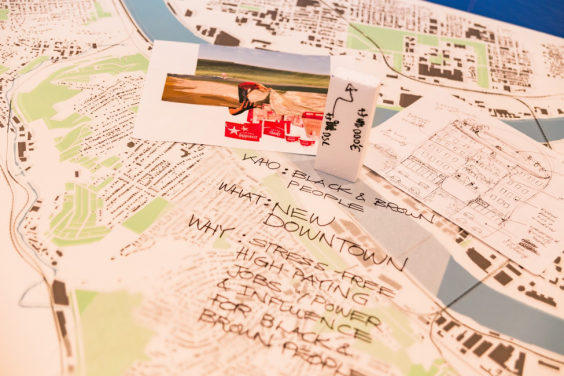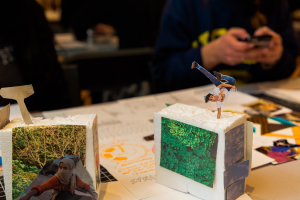Recognizing Hungers That Are Already There: A Conversation with Designer Mitch McEwen
by Leah Wulfman / January 12, 2017 / No comments
Active Cities and Activist Architectures
LW: Speaking of public infrastructure, what occurred in Flint, Michigan with lead contamination in the drinking water is along the same lines of what happened with our water here in Pittsburgh, where a private company was brought on to manage the public water supply. Post-Trump’s election, we are seeing an explosion of open Google documents with individuals sourcing and supporting alternative economies and community practices—from #grabyourwallet, boycotting businesses and corporations that support Donald Trump, to supporting nonprofits that support women and minorities. How should we see alternative architecture practices as a voice and player in this dialogue, whether that’s supporting alternative coursework in architecture curriculums, supporting alternative and smaller practices that do not exploit architecture laborers, etc.?
MM: We have to mobilize quickly. Cities have already had to be ahead of the federal government on key issues even during the Obama Administration, in terms of adapting to climate change, or trying to understand affordable housing. Politicians did not just recently show up with neoliberal agendas. That’s been happening at the federal level for decades, but we now see them—Republicans especially—being more aggressive with their strategies in response to sanctuary cities, the climate change accords, etc.. We are going to see it with Los Angeles, New York, and Chicago; the cities will have to make direct agreements with other countries on their own. There is going to be a whole other level of municipal engagement.
LW: We are going to have understand our cities as part of an international community where we can connect and empower ourselves and our cities and not just feel disempowered and punished from the federal and state level.
MM: Yes, cities are going to have to stand up and lead the country. Architecture is in a good place if we can be nimble, looking ahead and undistracted. There is the ridiculous rhetoric from the American Institute of Architects (AIA), saying that architects are lined up to take part with Trump’s infrastructure projects. For architects who are ready to do the work that is going to be necessary, we just have to be focused. We don’t have time for that sort of silliness. We have to be ready to jump in.
LW: In a recent lecture with Michael Murphy, co-founder of the MASS Design Group, architect-urbanist Michael Sorkin also rejected the AIA’s offer for cooperation with Trump. Calling for architects to rally against proposals that institutionalize racial discrimination and anti-immigrant priorities, Sorkin wrote, “We call upon the AIA to stand up for something beyond a place at the table where Trump’s cannibal feast will be served. Let us not be complicit in building Trump’s, wall but band together to take it down.”
We need to be in a situation where we can recognize the hungers that are already there.
MM: Yes, it’s ridiculous. We can’t even be distracted. We cannot allow ourselves to be distracted with this wall mess. We have to be actively engaging with sanctuary cities and issues of immigration. We basically have to come up with a hybrid of CIAM (International Congress of Modern Architecture) and the Underground Railroad, like, now. We need all hands on deck. We need to continue to engage with municipal governments, non-profits, and the multiplicity of ways that people in civil society will be organizing resistance. It’s already happening. So, we need to keep our eyes open, be curious and be ready to work.
LW: I think that speaks to the success of what you generated at SUPERFRONT, and the success of ideas that physically manifest themselves in a place. I volunteered at The Big Idea Bookstore, a non-profit, cooperative radical bookstore in Pittsburgh’s Bloomfield neighborhood over five years ago now, but a takeaway for me was the success inherent in occupying a physical location, in visibility, in ideas and information made physical, and the success of open access even to a computer and to the internet. Many individuals and communities still don’t have access to the internet, so when so much organizing and activism takes place online, accessibility to information is still a big issue.
MM: I was at Occupy Wall Street in 2011. I lived in New York at the time, so I wasn’t sleeping there. I was there co-organizing the architecture working group. There were architects already involved with the group when I first got there, but they weren’t calling themselves architects. They were part of the brilliance behind the Kitchen, and anyone who knows anything about Occupy Wall Street knows that Kitchen was the key working group that made everything else possible. It all came down to General Assembly where direct action were planned and decided upon. Kitchen was the working group which allowed everyone else to live there, congregate there, socialize there, jam, think and get the work done. You can’t do it if you are starving. If you don’t have a shared place where everybody can eat, you can’t all get together as a community and get stuff done. So, Kitchen had all this coordination intelligence which was actually very architectural. I think of often as an example of what we are going to have to do at a national level, being able to step outside of the typical role of architect. When I look at what made architects a productive part of Kitchen, it’s that we have this amazing capacity to coordinate information and to coordinate people.
Reframing Architectural Practice
LW: Speaking of her interest in architecture as a speculative act and material proposition, Robin Coste Lewis, poet and author of Voyage of the Sable Venus, mentioned the other day in response to your, Imani Day and Mario Gooden’s talks that she is constantly inspired by architecture, and as she sees it, architecture is always of and for the future. Not to bring it back to another old white man, but this reminds me of Marcel Proust suggesting that “(t)he real voyage of discovery consists not in seeking new landscapes, but in having new eyes.” English architect and intellectual Cedric Price concluded, “So that is another rule for the whole nature of architecture: it must create new appetites, new hungers—not solve problems, architecture is too slow to solve problems.”
MM: Being able to be in a dialogue with amazing poets and artists, with the Center for African American Poetry and Poetics (CAAPP) at the University of Pittsburgh, is amazing for me because it’s about providing space and language for things that you know and feel. It is this expression which in certain fields is hidden and goes so unstated that you don’t even know how to reach for it.
In the meantime, we need to be a part of engaging with people in ways that may not seem like typical architecture, but that are working on setting up situations where there can be a fulfillment of hungers that are already there. There is a hunger: there are people that don’t have places to live; there are people being pushed out of their apartments; there are all these kinds of lacks that have been and are still being produced.
Continue reading this article on page 4






